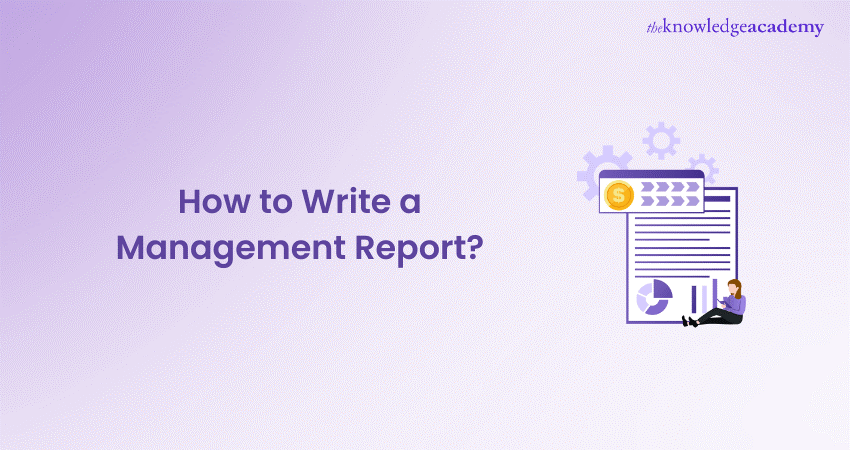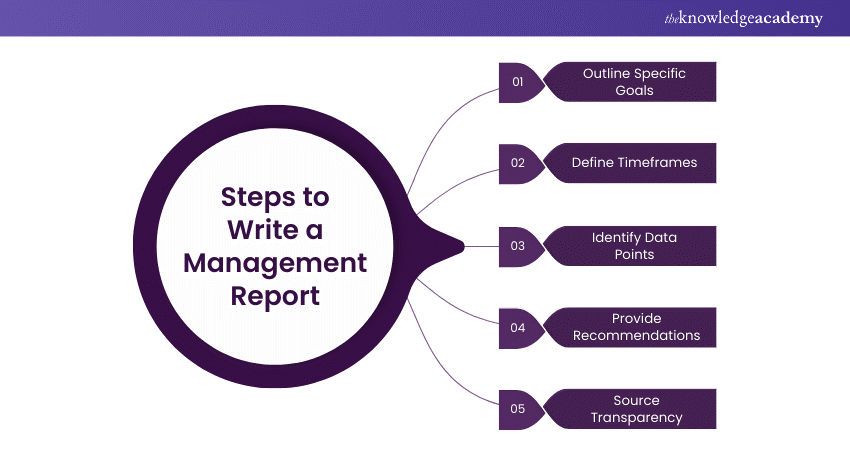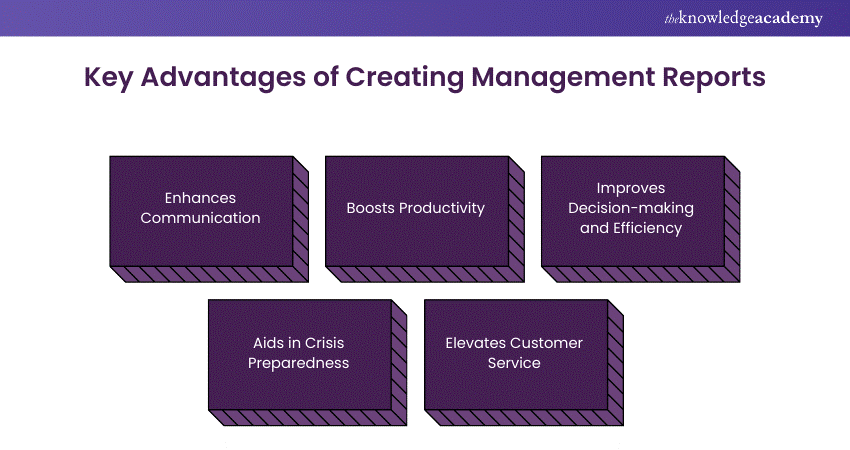We may not have the course you’re looking for. If you enquire or give us a call on +33 805638382 and speak to our training experts, we may still be able to help with your training requirements.
Training Outcomes Within Your Budget!
We ensure quality, budget-alignment, and timely delivery by our expert instructors.

Managing a team without a proper Management Report is like navigating a ship without a compass or map. Management Reports serve as the compass guiding your organisation's strategic decisions. By mastering How to Write a Management Report, you ensure that stakeholders are well-informed with vital data, leading to efficient decision-making and successful project outcomes.
In this blog, you will learn How to Write a Management Report, along with its advantages and the challenges involved in creating one. Let’s dive in!
Table of Contents
1) What is a Management Report?
2) Steps to Write a Management Report
a) Establish Goals for Your Staff
b) Emphasise Clarity
c) Maintain Objectivity
d) Utilise Visual Elements
e) Align the Report with Customer Needs
3) The Advantages of Creating Management Reports
4) Challenges in Management Reporting
5) Conclusion
What is a Management Report?
A Management Report is a business document that compiles data from various departments to monitor overall performance. It typically tracks elements such as budget, cash flow, wage-revenue ratio, employee productivity, and client profitability.
Presented concisely and clearly, this information helps managers track performance, identify trends, analyse data, align with overall goals, and make better-informed decisions for the organisation.
Essentially, it shows the value of your company. Management Reports can be created on a weekly or monthly basis, based on the size and complexity of the business.
Steps to Write a Management Report
Before writing a Management Report, it's crucial to understand its purpose. A Management Report compiles operational data from various departments, presented in a clear format to aid informed decision-making. Let’s explore How to Write a Management Report with detailed steps:

1) Establish Goals for Your Staff
a) Outline Specific Goals: Clearly state the department's objectives.
b) Define Timeframes: Specify the reporting period and expected completion times for goals.
c) Identify Data Points: Highlight key indicators to track progress.
d) Provide Recommendations: Offer actionable advice for achieving goals.
e) Source Transparency: Indicate where data is collected and how to discuss it further.
2) Emphasise Clarity
a) Summarise Results: Ensure each point is clear and unambiguous.
b) Cater to Different Audiences: Provide both detailed data and clear instructions for those less familiar with data analysis.
3) Maintain Objectivity
a) Objective Reporting: Present data and conclusions without personal bias to maintain credibility and accuracy.
b) Integrity: Ensure honest evaluations to benefit the company and employee growth.
4) Utilise Visual Elements
a) Use Graphs and Visuals: Include important KPIs in visual formats for easier understanding.
b) Highlight Key Metrics: Focus on 3-6 crucial KPIs related to department performance.
5) Align the Report with Customer Needs
a) Include Customer Data: Integrate customer feedback and opinions to align department output with customer expectations.
b) Impersonal Perspective: Use external data to provide an unbiased view of company performance.
By following these steps, you can create a comprehensive and effective Management Report that aids in decision-making and enhances organisational performance.
Become familiar with how to assume human nature and managerial behaviour with our CMI Level 4 Certificate in Management and Leadership - Register today!
The Advantages of Creating Management Reports
Management Reports are essential for smooth business operations and provide numerous benefits:

1) Enhances Communication
Management Reports ensure consistent access to information for both upper and lower management, facilitating clearer communication and easier problem identification. This transparency builds trust and strengthens long-term relationships within the organisation.
2) Boosts Productivity
Effective Management Reports promote cross-departmental cooperation and reduce effort duplication. They save managers time by providing readily accessible data, allowing them to focus on strategic tasks and boost overall productivity.
3) Improves Decision-making and Efficiency
Management Reports provide a comprehensive view of the company's operations, highlighting areas of success and improvement. This reliable data aids in making informed decisions and optimising business efficiency.
4) Aids in Crisis Preparedness
By tracking progress and monitoring performance, Management Reports help identify potential problems early. This allows for timely preventive measures, mitigating the risk of minor issues escalating into major crises.
5) Elevates Customer Service
Data-driven Management Reports offer insights into customer needs and preferences. This enables managers to make informed decisions that enhance customer service and satisfaction.
Understand how to implement and evaluate the personal development plan with our CMI Level 4 Diploma in Management and Leadership - Sign up now!
Challenges in Management Reporting
Management Reporting presents various challenges, especially as companies grow internationally and data management becomes more complex. Here are some key challenges faced in Management Reporting:
1) International Management Reporting Complexities
Many companies generate significant revenue abroad, leading to the establishment of international subsidiaries, investment holdings, and joint ventures. These entities must be included in consolidation and Management Reporting, which creates several challenges:
1) Country-specific reporting requirements
2) Different languages, currencies, and number formats
3) Heterogeneous data formats and sources
4) Diverse system landscapes and database formats
5) Decentralised organisational structures and reporting responsibilities
2) Ensuring Data Quality in Reports
The Management Reporting process is often inefficient and prone to errors due to varying formats, release statuses, databases, and manual data merging. This can lead to delays in obtaining relevant financial data for strategic decisions and may result in inaccurate reports that misinform strategic decisions.
3) The Role of Excel in Management Reporting
Using Excel exclusively for financial statements and reports presents several issues:
1) Inconsistent data quality and management difficulties due to the lack of a uniform data model.
2) Limited interfaces to ERP and other databases.
3) Multiple Excel databases with varying versions of the same data.
For companies that consolidate data, additional challenges include:
1) Inability to perform intercompany reconciliation
2) Difficulty in conducting parallel audits in accordance with HGB, IFRS, or GAAP
3) Lack of software certification by auditors, which stakeholders often prefer
Addressing these challenges requires adopting more robust and integrated reporting systems to ensure accuracy, efficiency, and compliance in Management Reporting.
Conclusion
We hope you gained insights on How to Write a Management Report after reading this blog. Understanding this process is crucial for effective business operations. By setting clear goals and focusing on clarity, you can create comprehensive and insightful reports. Remaining unbiased and using visual aids are also essential. Relating the report to customer data further enhances its value. These practices ensure that your Management Report is a valuable tool for informed decision-making and strategic planning.
Register for our CMI Level 4 Award in Management and Leadership and learn about the internal and external factors influencing organisational culture.
Frequently Asked Questions

Structure a Management Report by starting with an executive summary, followed by clear sections for objectives, methodology, data analysis, findings, and recommendations. Use headings, bullet points, and visual aids to enhance readability and ensure logical flow.

Ensure accuracy by using reliable data sources, cross-verifying information, and employing consistent data collection methods. Review the report for errors, consult subject matter experts, and use automated tools to minimise manual data entry mistakes.

The Knowledge Academy takes global learning to new heights, offering over 30,000 online courses across 490+ locations in 220 countries. This expansive reach ensures accessibility and convenience for learners worldwide.
Alongside our diverse Online Course Catalogue, encompassing 17 major categories, we go the extra mile by providing a plethora of free educational Online Resources like News updates, Blogs, videos, webinars, and interview questions. Tailoring learning experiences further, professionals can maximise value with customisable Course Bundles of TKA.

The Knowledge Academy’s Knowledge Pass, a prepaid voucher, adds another layer of flexibility, allowing course bookings over a 12-month period. Join us on a journey where education knows no bounds.

The Knowledge Academy offers various CMI Level 4 Training, including CMI Level 4 Award in Management and Leadership Training and Health and CMI Level 4 Certificate in Management and Leadership Training. These courses cater to different skill levels, providing comprehensive insights into the Leadership and Management Skills.
Our ILM, CMI Leadership & Management Blogs cover a range of topics related to CMI Level 4, offering valuable resources, best practices, and industry insights. Whether you are a beginner or looking to advance your Leadership Skills, The Knowledge Academy's diverse courses and informative blogs have you covered.
Upcoming ILM, CMI Leadership & Management Resources Batches & Dates
Date
 CMI Level 4 Award in Management and Leadership Training Course
CMI Level 4 Award in Management and Leadership Training Course
Fri 21st Feb 2025
Fri 25th Apr 2025
Fri 20th Jun 2025
Fri 22nd Aug 2025
Fri 17th Oct 2025
Fri 19th Dec 2025







 Top Rated Course
Top Rated Course



 If you wish to make any changes to your course, please
If you wish to make any changes to your course, please


